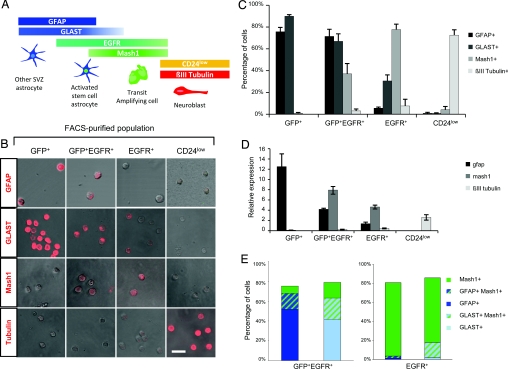Fig. 3.
Purity and marker expression of FACS-purified SVZ populations. (A) Schema represents the SVZ stem cell lineage and the markers enriched at each cell stage. Activated stem cell astrocytes give rise to rapidly dividing transit amplifying cells that differentiate into migrating neuroblasts and eventually give rise to mature neurons of the olfactory bulb. A small percentage of SVZ stem cells differentiate into oligodendrocytes (not shown in the schema). Note that some markers are not specific to one cell type and persist into the following stage of the lineage. (B) Acute immunostaining of SVZ populations purified by FACS from the adult mouse brain. FACS-purified SVZ astrocytes (GFP+), activated stem cell astrocytes (GFP+EGFR+), transit amplifying cells (EGFR+), and neuroblasts (CD24low) were stained with antibodies against GFAP, GLAST, Mash1, and βIII-tubulin (TuJ1) to analyze the purity of each fraction. (Scale bar, 20 μm.) (C) Quantification of acute immunostaining. Data represent the mean percentage ± SEM of cells expressing the different markers in each of the FACS-sorted populations from 5 independent experiments. (D) Relative quantities of gfap, mash1, and βIII tubulin mRNA detected by qRT-PCR in each of the FACS-sorted populations. Data represent relative quantity normalized to gapdh. (E) Quantification of acute double immunostaining for GFAP/Mash1 (Left) and GLAST/Mash1 (Right) in the activated stem cell population (GFP+EGFR+) and transit amplifying (EGFR+) populations. Images of the acute immunostainings are shown in Fig. S4.

